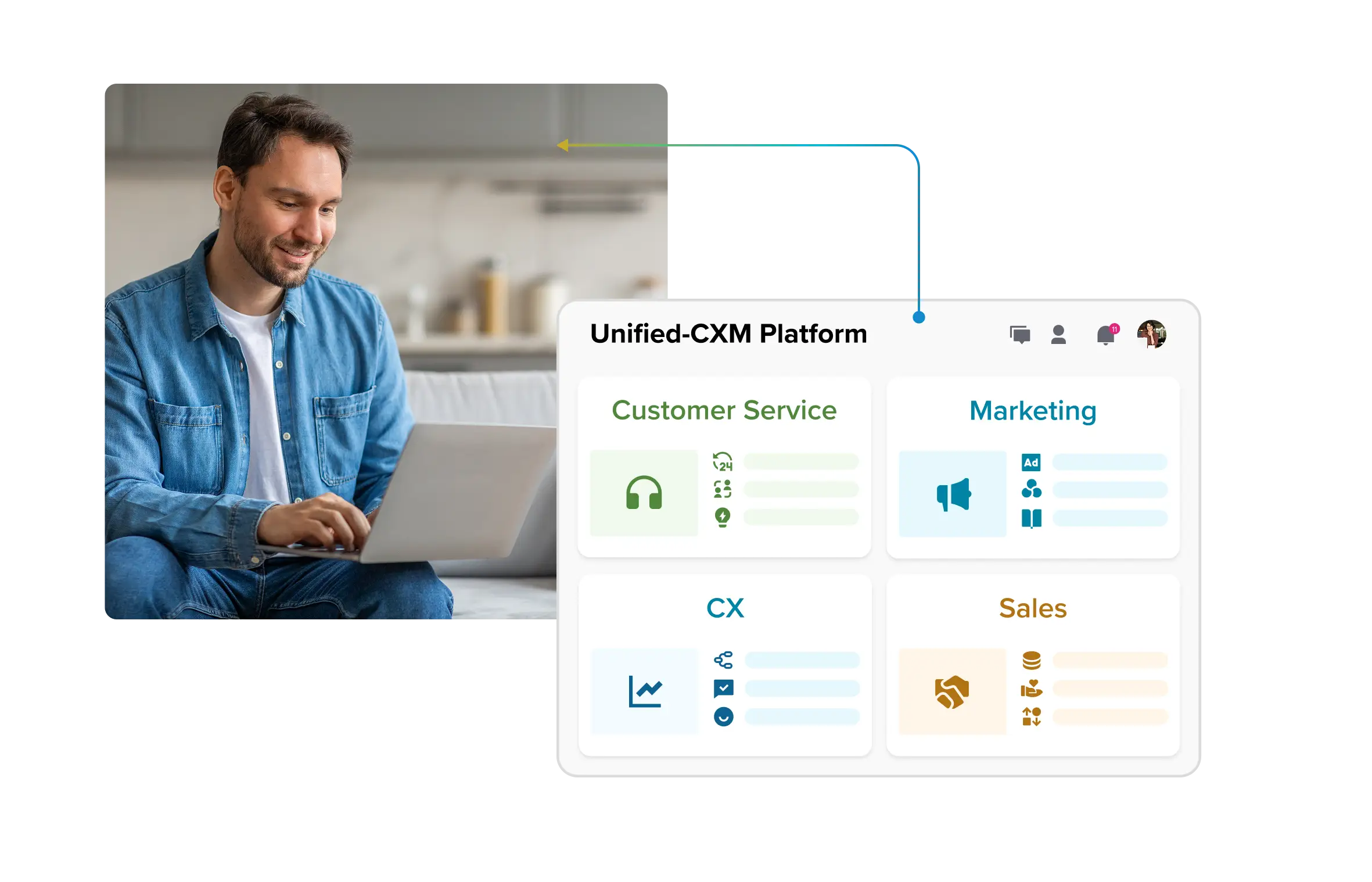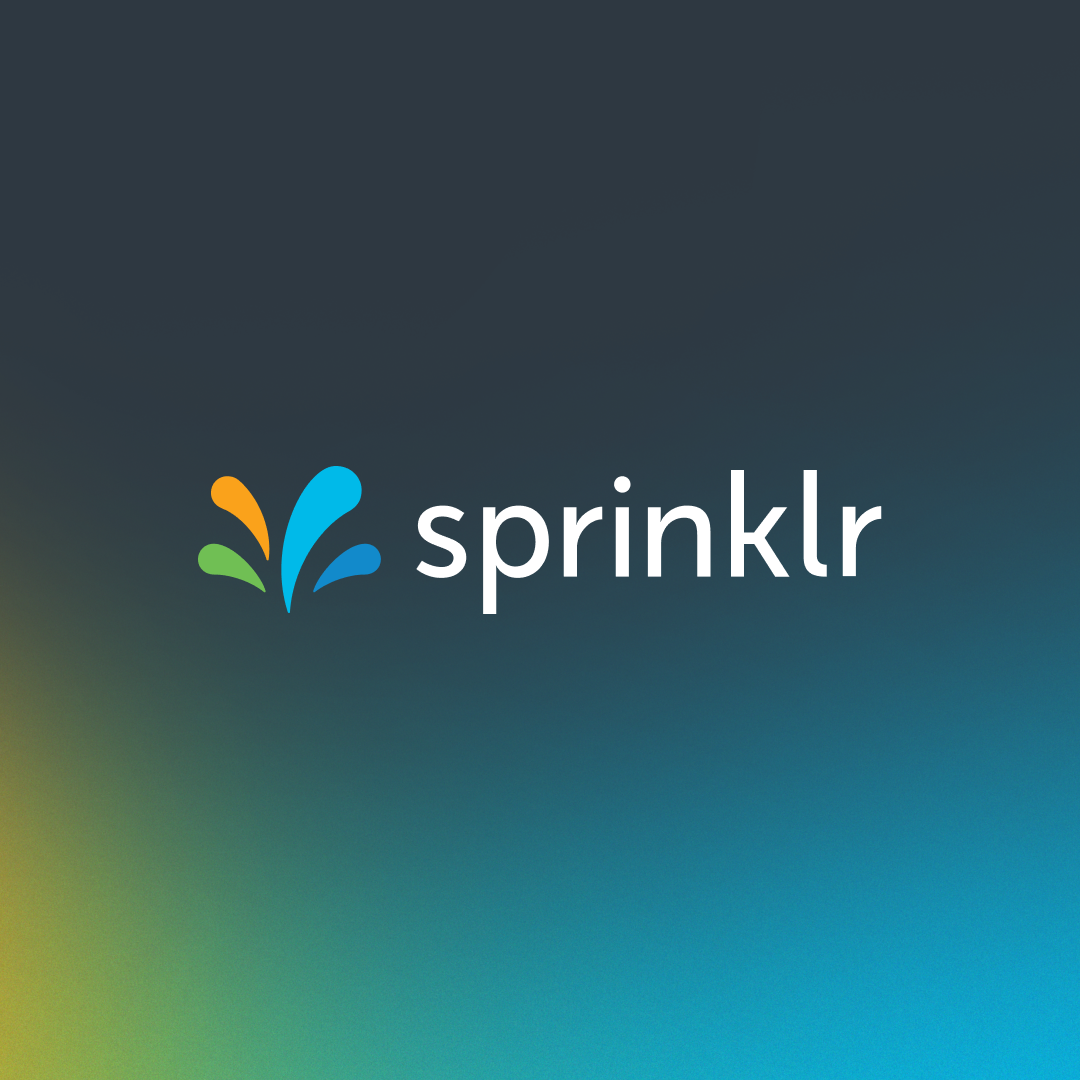The strategic AI-native platform for customer experience management
The strategic AI-native platform for customer experience management. Unify your customer-facing functions — from marketing and sales to customer experience and service — on a customizable, scalable, and fully extensible AI-native platform.

Customer Experience Automation in the AI Era: What’s the Strategic Advantage?
A customer calls an airline after being charged twice for the same transaction. While waiting in the queue, an intuitive IVR detects a potential delay and seamlessly deflects the customer to WhatsApp. Within moments, the airline’s AI assistant processes the refund, shares the boarding pass, and even helps the traveler pre-order their favorite drink — all in one thread.
What began as a frustrating experience transformed into a moment of delight. The brand not only resolved the issue swiftly but also anticipated needs and automated the journey, earning loyalty in the process.
That’s the power of customer experience automation. When done right, it becomes your always-on retention engine. Predictive, proactive, and deeply personal. But let’s be honest: most brands still haven’t cracked the code.
In fact, studies say 48% of businesses admit their customer experience still falls short of expectations, while only 31.5% say it exceeds them. That’s a gap, but also a massive opportunity.
In this blog, we’ll explore what customer experience automation really means in the AI era, why it’s critical, where brands go wrong, and how the smartest enterprises are reshaping customer experience at scale in 2025 and beyond.
What is customer experience automation (CXA)?
Customer experience automation (CXA) refers to the use of AI-powered workflows and decision engines to streamline and personalize customer interactions across channels at scale. It empowers enterprises to deliver consistent, proactive, and context-aware support through every stage of the customer journey without always needing a human in the loop.
Key components of CXA include:
- AI-powered chatbots and conversational AI: These handle routine inquiries and actions, from order updates to product recommendations, while learning from every interaction to improve over time.
- Omnichannel orchestration: Customer experience automation connects all customer touchpoints, such as voice, live chat, email, messaging apps, and social media, so conversations can move fluidly across channels without customers needing to repeat themselves.
- Intelligent routing and workflows: AI routes inquiries to the right agent or self-service path based on urgency, intent, and customer history, reducing wait times and increasing resolution speed.
At its core, CXA enables the experience today’s customers expect: 24/7 availability, lower friction, and personalized support, often without speaking to a live contact center agent. For enterprises, it means faster resolutions, reduced operational overhead, and the ability to scale customer service without compromising quality.
Stages of CX automation: How to know where you stand
Customer experience automation doesn't happen overnight. It evolves in stages, each unlocking a new level of efficiency, personalization, and strategic impact. Here's how to assess your current maturity level and what it means for your business:
1. Reactive stage
At this foundational stage, automation is limited to basic, post-issue workflows. Think FAQ chatbots or auto-responses to common email queries. You're solving surface-level problems after customers reach out, with little ability to personalize or anticipate their needs. While this helps deflect simple tickets, the experience remains transactional and inconsistent.
2. Operational stage
You're automating routine customer service workflows across multiple channels, such as chat, email, and social. Automation is now embedded in day-to-day support processes, helping reduce manual effort and drive consistent responses. At this point, you've gained operational efficiency, but customer interactions still feel generic.
3. Strategic stage
Automation now becomes proactive and personalized. You're leveraging AI and customer data to tailor interactions, predict intent, and deliver relevant real-time experiences. This is where customer satisfaction and loyalty begin to climb because you're showing up with the right message at the right moment on the right channel.
4. Predictive / Autonomous stage
This is the CX automation endgame. AI anticipates customer needs before they're expressed, orchestrating end-to-end, personalized experiences across the entire customer journey.
Real-time data, intent signals, behavioral patterns, and continuous learning power seamless automation with minimal human intervention. At this level, CX becomes a strategic moat.
The strategic edge of customer experience automation
In enterprise environments, scale is both a strength and a vulnerability. As digital interactions explode across communication channels and touchpoints, the pressure to deliver fast, frictionless, and context-rich experiences without ballooning costs is relentless.
This is where customer experience automation makes the difference. Let’s see how:
1. Taming complexity at scale
Today’s customer journey is fragmented across websites, mobile apps, social platforms, email, and messaging services. Customers expect brands to keep up — to know who they are, remember past interactions, and provide immediate help. Without customer experience automation, agents are left chasing history across systems. Conversations feel disjointed, and the brand experience takes a hit.
AI-powered customer experience automation changes the equation. With capabilities like omnichannel orchestration, unified interaction history, and NLP-based intent recognition, you can deliver consistent, seamless interactions, no matter where the journey starts. The result is immediate customer trust built through continuity and context.
2. Closing the expectation–execution gap
Customer expectations evolved from just resolution to recognition faster than most enterprises could keep up. Unsurprisingly, many organizations still operate on legacy systems designed for a pre-digital era. Manual processes, rule-based scripts, and siloed workflows leave little room for personalization at scale.
CX automation solves this gap. Pulling data from CRMs, past interactions, behavioral signals, and third-party systems enables real-time, personalized engagement without adding agent load. Imagine a high-value customer showing churn signals based on sentiment analysis and NPS trends. CX automation can proactively trigger a personalized retention offer before the customer even reaches out. That’s how automation shifts customer experience from reactive to anticipatory, creating a new layer of strategic value.
3. Freeing human agents for high-impact work
In most contact centers, a significant portion of inbound queries, such as order tracking, account updates, and billing questions, are repetitive and low in complexity. These eat into valuable agent hours that should be directed toward complex problem-solving and customer relationship building.
CX automation handles these routine tasks with AI-powered virtual agents, whether through a chatbot on the website or an in-app assistant. These systems can instantly resolve Tier-1 queries, reducing both handling time and operational load.
Take a telecom enterprise, for example. AI bots can manage plan upgrades, usage inquiries, or account changes at scale, freeing human agents to focus on higher-value conversations around churn prevention, upselling, and complaint resolution.
💡Do you know
Sprinklr's Conversational AI platform was pivotal in transforming the contact center operations of Banco Santander Brasil. The bank reduced its live agent workload by 14% by enabling greater customer self-service.
With fewer interactions routed to agents and better preparation when human support was required, the net promoter score (NPS) for agent-assisted cases surged by approximately 35%. This reflected efficiency and increased customer satisfaction driven by faster, more personalized service powered by Sprinklr.
4. Reducing operational drag
It's not uncommon for agents in large contact centers to juggle multiple systems just to complete one customer interaction. Switching between CRMs, order databases, ticketing tools, and internal knowledge bases slows resolution times and drives up error rates and employee burnout. This fragmentation is one of enterprises’ biggest silent cost centers.
A unified agent desktop, powered by intelligent automation, solves this by bringing all the context an agent needs onto a single pane of glass. It syncs data in real time, summarizes historical conversations, and surfaces the next-best actions without the agent needing to search across tools. The result is faster resolutions, fewer escalations, and empowered agents who can actually focus on the customer rather than the tools.

5. Powering 24/7 global support without the overhead
Whether it's midnight in Singapore or early morning in New York, customers want instant, reliable service in their preferred language on any channel. Traditional staffing models struggle to keep up. Building human support coverage across all time zones is resource-heavy, inconsistent, and increasingly unsustainable.
This is where intelligent customer experience automation changes the game. AI-powered virtual agents can deliver always-on multilingual customer support across chat, voice, and messaging platforms, ensuring every customer gets a consistent, high-quality experience regardless of location or hour.
CX automation also ensures a warm handoff with a full interaction history when an issue requires human intervention, eliminating repeat explanations and reducing handling time. Here’s how it works with Sprinklr👉: Omnichannel handover protocol
6. Turning data into real-time action
This real-time responsiveness moves CX from reactive and report-driven to adaptive and insight-led. It’s how you stop looking backward and start shaping the experience as it unfolds.
7. Future-proofing the enterprise for autonomous CX
CX automation gives you more than efficiency; it provides a stable, intelligent foundation that can adapt quickly, absorb surges in demand, and evolve with customer behavior. During crises, seasonal spikes, or product recalls, AI systems can scale instantly, prioritize high-risk interactions, and ensure business continuity without burning out human teams.
More importantly, automation isn’t static. It learns. It improves. With every conversation, it fine-tunes responses, updates knowledge, and sharpens predictions.
In the AI era, the most successful enterprises will not just provide great service. They will also have intelligent infrastructure that keeps them responsive, resilient, and relentlessly customer-centric.
Advanced technologies shaping the future of CX automation
Customer expectations keep evolving, and your tech stack should, too. Here’s what you need to watch out for:
Autonomous agents managing complex customer journeys
Gartner predicts agentic AI will resolve 80% of routine customer service issues by 2029, reducing operational costs by 30%. Unlike basic bots, these agents work together — sharing data, understanding context, and automating multi-step journeys.
Imagine a complex enterprise software renewal. Autonomous agents analyze usage data, forecast needs, suggest training, and tailor real-time offers — no human input is needed. That’s a faster, scalable, hyper-personalized customer experience.
Also Learn: Why Enterprises Need to Invest in Agentic AI in 2025
Generative AI for hyper-personalized interactions
Most enterprises rely on scripted bots or templated responses that lack nuance. This limits personalization, especially in high-emotion or high-value scenarios. Generative AI brings contextual awareness and natural dialogue generation. Whether crafting empathetic responses to complaints or tailoring product suggestions, it enables real-time, human-like interactions at scale. You can fine-tune models to reflect brand tone, industry-specific vocabulary, and compliance needs.
AI-powered decision engines
Rules-based systems hit a ceiling when customers expect more than “if this, then that.” Static logic fails in dynamic customer service scenarios.
AI decision engines continuously learn from data and outcomes to select the most effective next-best action — whether it’s triggering a retention offer, escalating a case, or switching from bot to human. These engines optimize for customer satisfaction and business KPIs like AHT, FCR, and CLV.
Low-code automation platforms
Scaling automation is often bottlenecked by long development cycles and IT dependency, delaying innovation. Low-code/no-code CX platforms allow you to design, test, and deploy customer service workflows without deep technical know-how. This speeds up experimentation, reduces cost, and empowers CX leaders to respond to changing customer needs in real time.
Multimodal interaction support
Customers use text or voice and often switch mid-interaction. Most CX tools aren’t built to handle this fluidity. Multimodal AI enables customers to engage using voice, text, images, or video within a single, unified experience. Imagine a customer snapping a picture of a damaged product in a chatbot flow while the AI processes it in real time, updates the ticket, and suggests a resolution — all without agent intervention.
RAG helps you scale generative AI without risking data control
Generative AI is powerful but cannot answer what it doesn’t know. Retrieval-augmented generation (RAG) solves that by pulling real-time data from enterprise systems, knowledge bases, and documents and using it to generate accurate, context-aware responses.
It blends the model’s language skills with your proprietary facts, giving you real-time, human-like answers without retraining or losing control. RAG is essential in regulated industries like healthcare and finance. It lets you deliver transparent, personalized CX at scale without risking compliance or data security.

Common CX automation challenges and how to solve them
Let’s look at the most common CX automation challenges enterprises face and how to tackle them with clarity, control and intelligent planning:
Challenge | Why it’s a problem | Strategic solution |
Siloed data and disconnected systems | Automation breaks down when systems don’t share data. Bots can’t recognize customers, and agents lack context. | Invest in a unified CXM platform that integrates all customer data streams in real-time. Use AI to unify interaction history and power contextual experiences. |
Low trust in AI decisions | Risk, legal, and CX leaders hesitate to fully automate customer interactions without visibility into how AI decisions are made. | Deploy explainable AI with audit trails and human-readable logic. Build trust with governance dashboards and human override options. |
Inflexible automation that doesn’t scale | Initial automation (like FAQs) doesn’t scale to complex workflows, creating maintenance debt and inconsistent experiences. | Use low-code, modular platforms that allow CX teams to deploy and update automation across diverse use cases without IT bottlenecks. |
Over-automation that kills empathy | Customers get stuck in rigid bot flows, especially in emotionally sensitive or complex scenarios, damaging trust. | Pair automation with intelligent escalation. Use real-time customer sentiment analysis to route cases to human agents with full context. |
Internal resistance and poor change management | Automation shifts team roles, causing friction across service, operations, and IT. Poor narrative leads to low adoption. | Launch CX automation as part of a broader transformation vision. Involve teams early, reskill staff, and align KPIs to outcomes beyond cost savings. |
Inadequate measurement of ROI | Reporting focuses narrowly on deflection rates or ticket volumes, failing to capture the full business impact. | Track metrics across CSAT, AHT, upsell/cross-sell revenue, agent productivity, and retention. Use AI-based forecasting for holistic ROI attribution. |
📌 Editor’s Pick: Customer Service ROI: How to Improve with AI in 2025
Automate with a strategic edge
If the AI era has made one thing clear, it's this: automation without intent is just noise. Every brand today has access to similar technologies, data, and channels. But the true differentiator is how strategically and intelligently you combine them.
Customer experience automation is no longer about cutting costs or speeding up response times. It's about anticipating needs before they're voiced. It's about connecting every touchpoint— web, mobile, voice, social — into one cohesive system that learns, adapts, and acts precisely without compromising trust or control. That level of orchestration takes more than a chatbot or a patchwork of tools. It demands a platform purpose-built for scale, real-time intelligence, and enterprise-grade security.
That's where Sprinklr Service comes in. Built on the Unified-CXM platform, Sprinklr Service is designed to orchestrate memorable customer experiences by integrating all human and virtual agents with every conversation and customer interaction across more than 30 digital and traditional channels. As a result, you automate processes seamlessly and operate with clarity, empathy, and a strong sense of purpose.
To see it in action, book a demo today!
Frequently Asked Questions
Yes. AI makes CX automation smarter. It predicts customer needs, routes tickets faster and personalizes real-time interactions across all channels.
Look for AI-driven routing, sentiment analysis, omnichannel support, real-time analytics and easy integration with CRMs. The platform should adapt and scale with your enterprise.
Yes. Automation cuts handling time, reduces repetitive tasks and frees agents for complex issues. It lowers costs while keeping service quality high.
Start with clear goals, map customer journeys, involve cross-functional teams, train agents to work with AI, not against it and measure what matters, like FCR and CSAT.
They uncover trends, detect friction points and guide smart decisions. Use real-time analytics to refine automation flows and tailor experiences at every step.










